Heinkel He 343
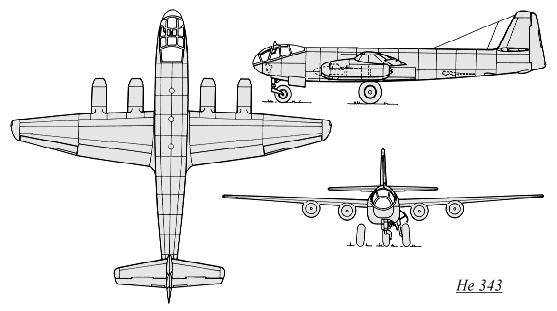 In January 1944, Heinkel was persuaded by Oberstleutnant Knemeyer to begin
work on a four-engined jet bomber, that could be ready in the quickest
possible time frame. Although Heinkel had been working on a similar project
(P.1068), it was decided to take a proven design
(Arado Ar 234) and enlarge the dimensions. The He 343 (this designation
was submitted to the RLM on March 14, 1944) was to have a 1.55:1
larger wing than the Ar 234, and the linear dimensions were to be increased
by 1.25:1. The He 343 was also know unofficially as the Strabo 16
(Strabo was an abbreviation for Strahlbomber (Jet Bomber),
and the takeoff weight was to be 16 tons), before the 343 number was issued.
In January 1944, Heinkel was persuaded by Oberstleutnant Knemeyer to begin
work on a four-engined jet bomber, that could be ready in the quickest
possible time frame. Although Heinkel had been working on a similar project
(P.1068), it was decided to take a proven design
(Arado Ar 234) and enlarge the dimensions. The He 343 (this designation
was submitted to the RLM on March 14, 1944) was to have a 1.55:1
larger wing than the Ar 234, and the linear dimensions were to be increased
by 1.25:1. The He 343 was also know unofficially as the Strabo 16
(Strabo was an abbreviation for Strahlbomber (Jet Bomber),
and the takeoff weight was to be 16 tons), before the 343 number was issued.
The enlarged
fuselage had space for an internal bomb bay and for the newly designed
main gear, which were double-braked. The wings were mounted mid-fuselage
and were unswept. Four jet engines were to be mounted singly beneath the
wings. The flexibility of the He 343 design really came into play here,
as virtually any turbojet could be used. At first, the Jumo 004B was to
be used, but it was hoped that the Jumo 004C would be ready by the time
the He 343 prototype was finished. Also, the BMW 003 or the He S 011 jet
engines could be fitted. On the planned production aircraft, the engines
needed to be moved forwards a bit to clear the planned single, trailing
edge flap. The nose and cockpit was newly designed, and a crew of two was
to sit in the pressurized cockpit. The nose gear
was also completely new, and was offset 100 mm (4 inches) to the port side
from the centerline of the aircraft.
There were four
main versions of the He 343 planned, these were:
-
He 343A-1, which was to be the bomber version.
Depending on the engines used, the bomb load ranged between 2000 kg to
3000 kg, with 2000 kg to be carried internally, and 1000 kg to be carried
externally. Trials were to be held with the Fritz X radio controlled bomb,
which would have also added a third view member. Defensive armament consisted
of two fixed rear firing MG 151 20 mm cannon with 200 rounds each, which
were mounted in the rear fuselage.
-
He 343A-2, the reconnaissance version, was to
be similar to the A-1, except instead of a bomb load, two Rb 75/30 cameras
were to be carried in the bomb bay, along with an additional fuel tank
that held 2400 kg of fuel to extend the range. Two fixed rear firing MG
151 20 mm cannon with 200 rounds each, as in the A-1, were mounted in the
rear fuselage for defensive fire purposes.
-
He 343A-3 was the first Zerstörer (Destroyer) version. The
standard armament was to be four forward firing MK 103 30mm cannon with
400 rounds each, which were mounted in the bomb bay, or two forward firing
MK 103 30mm cannon with 100 rounds each and two forward firing MG 151 20mm
cannon with 200 rounds each. Weapons with calibers of up to 50 mm could
be used, although all the forward firing guns had to be placed to fire
from the starboard side under the fuselage nose, due to the nose wheel
which retracted to the rear and was on the port side. Again, like the A-1
and A-2 variants, defensive armament consisted of two fixed rear firing
MG 151 20 mm cannon with 200 rounds each, which were mounted in the rear
fuselage.
-
He 343B-1, which was also to be a Zerstörer
(Destroyer), the main difference was that instead of the two fixed rear
firing guns in the fuselage rear, a FHL 151Z remote controlled turret was
installed in the extreme rear fuselage. This necessitated a tail redesign
to a twin fin and rudder set up. A rear facing periscope in the cockpit
was used to aim the FHL 151Z turret, which was armed with two MG 151 20mm
cannon. The twin tail would have made for extended flight testing, plus
would have added additional weight and drag.
Although the RLM sanctioned
20 total He 343 aircraft (including prototype and pre-production examples),
they were never very enthusiastic about Heinkel's four jet bomber. Plus,
the He 343 was in a battle for a contract with Junkers' forward swept wing
287, also a four jet bomber. Professor Heinkel went so far as to write
a very opinionated letter to the RLM, touting the 343's quicker development
time, lower material cost and basic simplicity, but it was to no avail.
The He 343 program was stopped in late 1944*, and all finished components
and construction jigs were either put into storage, or scrapped, due to
the worsening war situation, in which all aircraft construction was to
be concentrated on fighter aircraft.
*Some sources state that a prototype He 343 was completed,
but was either destroyed in a bombing raid or was scrapped before the first
test flight.
 View Heinkel He 343 model photos
View Heinkel He 343 model photos  View Josha Hildwine's He 343 Luft Art images
View Josha Hildwine's He 343 Luft Art images
Heinkel He 343 Dimensions**
| Span |
Length |
Height |
Wing Area |
18 m
59' 1" |
16.5 m
54' 2" |
5.35 m
17' 7" |
42.25 m²
454.78 ft² |
Heinkel He 343 Weights
| Empty |
Fuel |
Equipment |
Crew |
Bomb Load |
Takeoff |
9068 kg
19991 lbs |
5490 kg
12103 lbs |
1187 kg
2617 lbs |
200 kg
441 lbs |
2000 kg
4409 lbs |
17945 kg
39562 lbs |
Heinkel He 343 Performances
| Max. Speed |
Rate of Climb |
Ceiling |
Max. Range |
Takeoff Run |
Landing Speed |
| @ |
sea level |
825 km/h
513 mph |
| @ |
6000 m
19685' |
835 km/h
519 mph |
| @ |
10000 m
32808' |
770 km/h
478 mph |
|
| @ |
sea level |
15.3 m/sec
50.2 ft/sec |
| @ |
6000 m
19685' |
7.4 m/sec
24.3 ft/sec |
|
10000 m
32808' |
1620 km
1007 miles |
1425 m
4675' |
168 km/h
104 mph |
**Dimensions, weights and
performance data are for the Jumo 004C equipped, single vertical fin version
Heinkel He 343 Models
| Manufacturer |
Scale |
Material |
Notes |
| Airmodel AM0107 |
1/72 |
Vacuform & Resin |
Includes single and twin tail parts |
| Planet #042 |
1/72 |
Resin & Decals |
|
Heinkel He 343A-1 Bomber
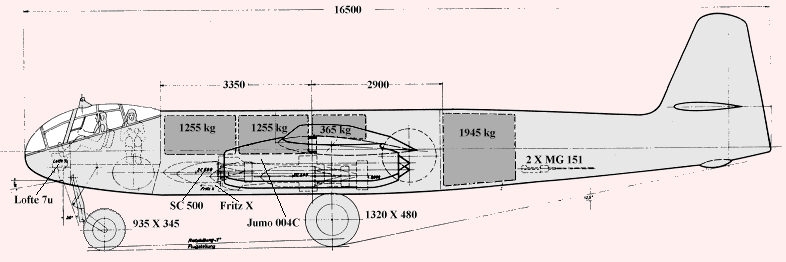
Heinkel He 343A-2 Reconnaissance
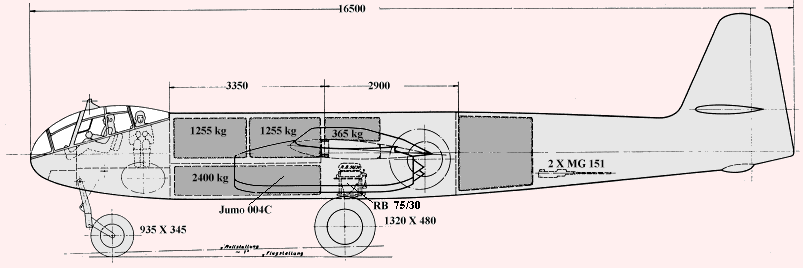
Heinkel He 343B-1 Zerstörer

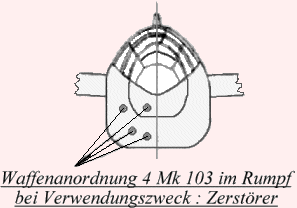
Weapon arrangement of 4 MK 103 in the
fuselage for use as a Zerstörer (Destroyer) |
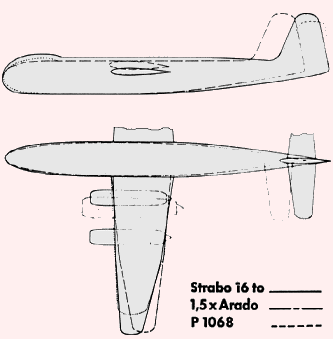 |
Heinkel He 343 V testing
V1 Work Number 850061
Basic prototype without bomb dropping equipment. Design
documents
up to April 15, 1944 are supplied. |
V2 Work Number 850062
Basic airframe for flight and engine testing. Will be
reconstructed for diving tests
after the first flights. Constructed according to the
plans delivered on the 19th of
April. The delivered catapult assemblies will be installed
later.Two catapults units
will be built. |
V3 Work Number 850063
Version supplied for weapons, radio and navigation testing.
An example with
the new Destroyer cockpit featuring armoured glass is
provided to contrast
against retrofitting of double glazing. Simplified undercarriage
with a reduced
track width. Design documents are supplied up to June
30, 1944. Documents are
supplied that relate to armouring and double glazing
up to July 30, 1944. |
V4 Work Number 850064
Version for released weapons test, including the Fritz-X
radio controlled bomb.
Similar to the V3, except the bomber conversion is to
be added, along with a
third seat. Design documents covering the period up to
15th August are supplied.
Six bomber conversion kits have been constructed to date. |
V5 Work Number 850065
Version for high altitude flight testing. All rivets
to be flush riveted for
range extension testing. |
V6 Work Number 850066
Version for material substitution. Sample supplied as
per destroyer version,
with wood surfaces, steel cross beams and plastic control
units. |
V7 Work Number 850067
All versions to be similar to V3 example. |
Original Heinkel nose wheel
drawings in 1:5 scale, dated April 4, 1944
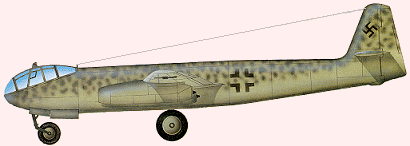
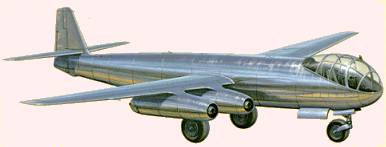
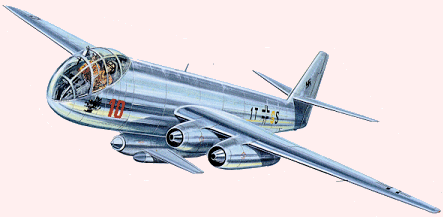
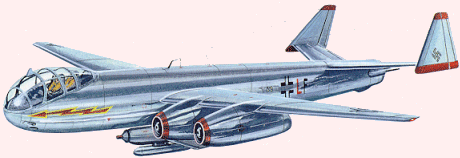
Images, top row: Luftwaffe
1946 - Wydawnictwo Military #12, Jet Planes of the Third Reich
- Monogram Aviation Publishing
bottom
row: Geheimprojekte der Luftwaffe Band II: Strategische Bomber 1935-1945
- Motorbuch Verlag
 In January 1944, Heinkel was persuaded by Oberstleutnant Knemeyer to begin
work on a four-engined jet bomber, that could be ready in the quickest
possible time frame. Although Heinkel had been working on a similar project
(P.1068), it was decided to take a proven design
(Arado Ar 234) and enlarge the dimensions. The He 343 (this designation
was submitted to the RLM on March 14, 1944) was to have a 1.55:1
larger wing than the Ar 234, and the linear dimensions were to be increased
by 1.25:1. The He 343 was also know unofficially as the Strabo 16
(Strabo was an abbreviation for Strahlbomber (Jet Bomber),
and the takeoff weight was to be 16 tons), before the 343 number was issued.
In January 1944, Heinkel was persuaded by Oberstleutnant Knemeyer to begin
work on a four-engined jet bomber, that could be ready in the quickest
possible time frame. Although Heinkel had been working on a similar project
(P.1068), it was decided to take a proven design
(Arado Ar 234) and enlarge the dimensions. The He 343 (this designation
was submitted to the RLM on March 14, 1944) was to have a 1.55:1
larger wing than the Ar 234, and the linear dimensions were to be increased
by 1.25:1. The He 343 was also know unofficially as the Strabo 16
(Strabo was an abbreviation for Strahlbomber (Jet Bomber),
and the takeoff weight was to be 16 tons), before the 343 number was issued.








